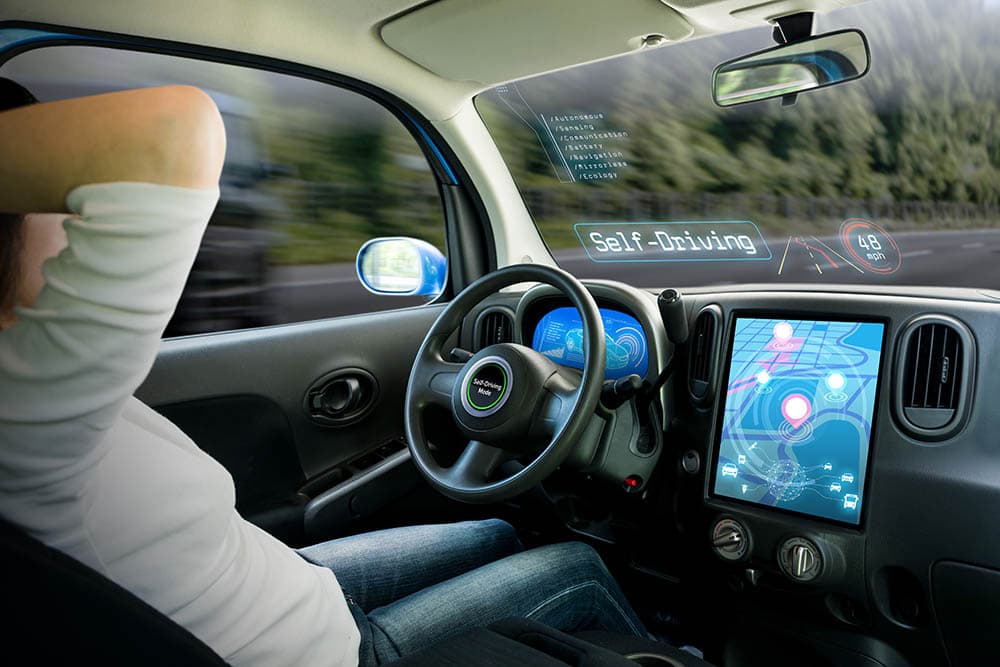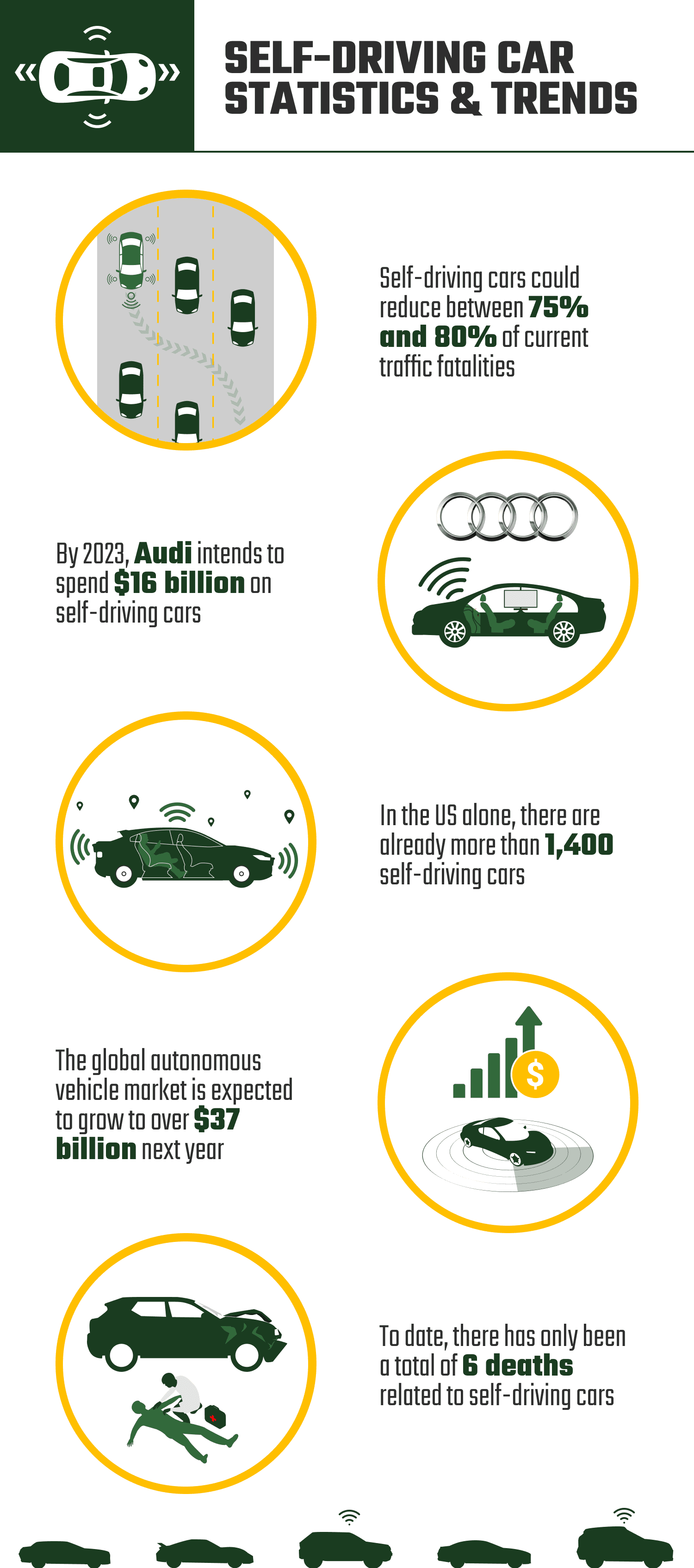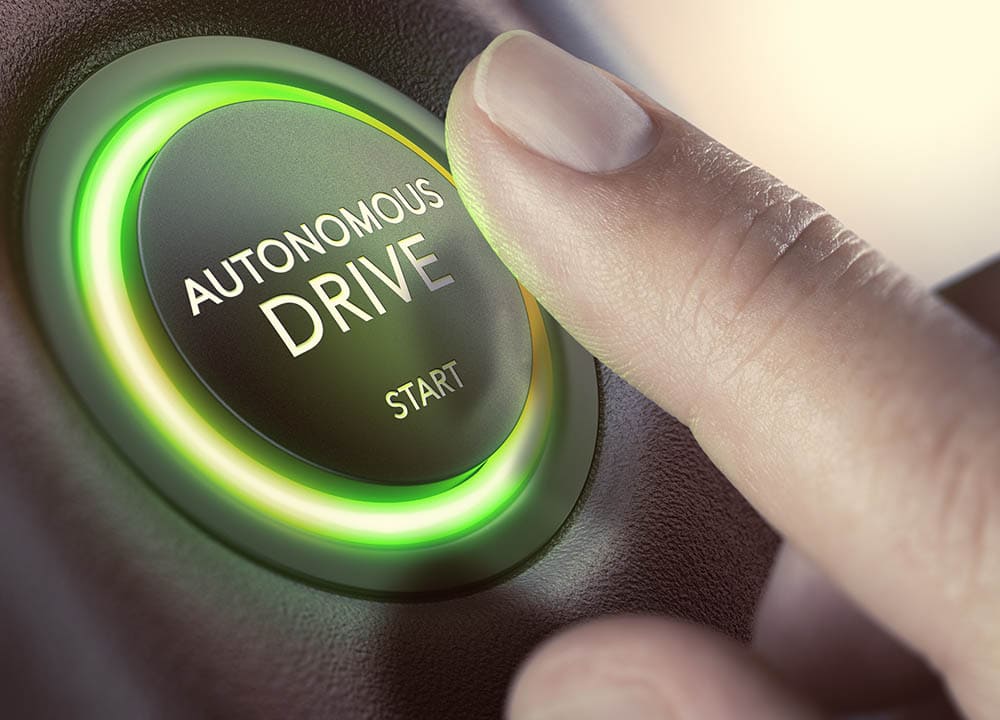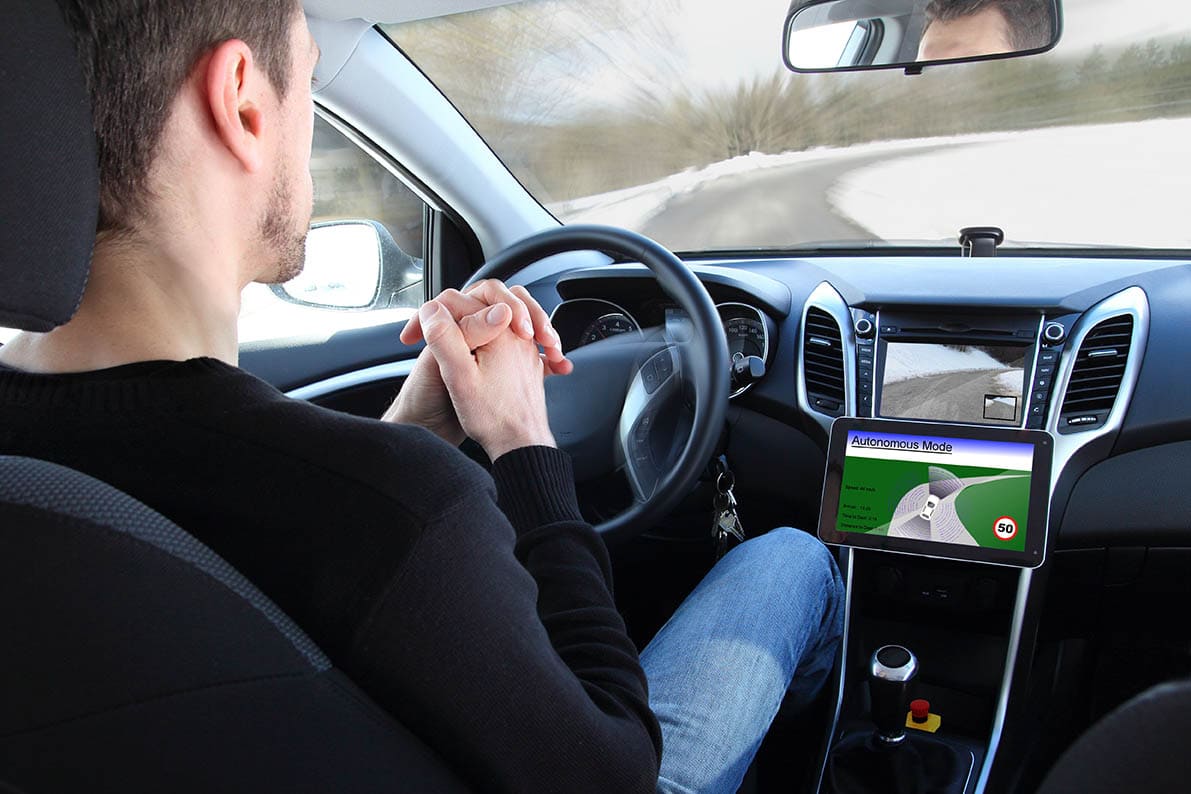10 Self-Driving Car Statistics and Trends – 2025 Update
-
Pete Ortiz
- Last updated:

Note: This article’s statistics come from third-party sources and do not represent the opinions of this website.
Self-driving cars go by a few different names: robo-cars, driverless cars, or autonomous vehicles (AV). These cars can sense the surrounding environment with little human interaction. Self-driving cars are the next big thing expected to change the world. However, making the transition from conventional cars to autonomous vehicles is likely to be slow at first. Still, self-driving cars are starting to become more popular. Also, driverless cars are quickly becoming a common sight on roads worldwide.
Self-driving cars have the power to change our lives. They may even save lives! It’s easy to get excited about self-driving cars, but it’s crucial to note that they won’t be commonplace right away. There are massive hurdles for self-driving cars to overcome in regulation, cost, and public perception.
As we approach the coming year, there’s a lot of excitement surrounding driverless or self-driving cars. There’s also a lot of chatter and false information around them. We feel it’s crucial to separate the truth from the hype in these 10 self-driving car statistics and trends.
Click below to jump ahead:
- Benefits of Self-Driving Cars
- Number of Self-Driving Cars and the Cost of Production
- Trends on Self-Driving Cars
Top 10 Self-Driving Car Statistics
- Self-driving cars could reduce 75-80% of current traffic fatalities.
- 69% of Americans believe that self-driving cars will help the elderly and people with disabilities move around.
- 72% of adults in the US say they would feel safer in a self-driving car only if they could control it in case anything goes wrong.
- By 2023, Audi (a German brand) intends to spend $16 billion on self-driving cars.
- In the US, there are more than 1,400 self-driving cars.
- The global autonomous vehicle market is expected to grow to over $37 billion in 2023.
- There will be no more traffic tickets with self-driving cars.
- There are 6 levels of automation in self-driving cars.
- To date, there has only been a total of 6 deaths related to self-driving cars.
- Car ownership could be cut by 70% over the next 15 years with self-driving cars.

Benefits of Self-Driving Cars
1. Self-driving cars could reduce 75-80% of current traffic fatalities.
(SCIENCE DAILY)
The most common cause of accidents is human error. It can be reduced by several means. For instance, these vehicles can reduce accidents considerably by reducing human error and improving driving behavior.
Second, autonomous vehicles can reduce traffic congestion by driving efficiently and closer together.

2. 69% of Americans believe that self-driving cars will help the elderly and people with disabilities move around.
(NCBI)
Many Americans believe that self-driving cars will help the elderly and people with disabilities. As more people discover how convenient, comfortable, and safe these cars are, they’ll likely become a common sight in many urban areas.
There are countless ways that self-driving vehicles can make life easier for all Americans. Of course, autonomous cars won’t be in every household for a long time. But there are still some clear benefits to these cars that could make them appealing to some consumers. They’re easy to use and safer compared to ordinary cars.
3. 72% of adults in the US say they would feel safer in a self-driving car only if they could control it in case anything goes wrong.
(NEWSROOM)
According to a recent survey by the News Room, people are interested in autonomous vehicles. But there is one thing stopping them from adopting this technology. It’s the lack of control on the part of the owner.
If you are driving, you can take control of the wheel if something happens. But with self-driving cars, a person doesn’t have control.
While most people would prefer to control their safety, it’s crucial to remember that self-driving cars will be programmed to prioritize safety over everything else. In other words, passengers can have as much control as they want. But the car won’t allow them to override its programming.
Number of Self-Driving Cars and the Cost of Production
4. By 2023, Audi (a German brand) intends to spend $16 billion on self-driving cars.
(CNET)
The German automaker (Audi) has said that it plans to invest 16 billion dollars in autonomous cars by 2023. The investment will spread over several years.
This move is part of the company’s plan to invest $24.5 billion into electric and autonomous vehicles. But the company is investing in the technology for its brands before pursuing partnerships with other companies.
The technology is growing fast, and in the next five years, more than half of the cars sold in Germany will be autonomous. It’s excellent news for carmakers because self-driving vehicles are likely going to be safer than their human-driven counterparts.

5. In the US, there are more than 1,400 self-driving cars.
(POLICY ADVICE)
There are several self-driving cars, approximately 1,400 in the United States. That may seem like a lot, but it accounts for just a tiny fraction of the vehicles on the road.
A big part of what makes these vehicles safer than human-driven ones is the computer power behind them. The cars use different kinds of sensors. They can detect everything from traffic lights to people crossing the street and other vehicles on the road.
The sensors feed data into a computer. It combines that information with mapping data and sophisticated machine learning algorithms.
6. The global autonomous vehicle market is expected to grow to over $37 billion in 2023.
(STATISTA)
Despite the economic slowdown in 2020, the autonomous vehicle market is making a comeback. The market is expected to grow to over $37 billion by 2023. By then, there should be more advances in how the cars work, making them more accessible to more people globally.
Trends on Self-Driving Cars
7. There will be no more traffic tickets with self-driving cars.
(POLICE CHIEF MAGAZINE)
Human drivers are prone to mistakes for which they may receive tickets from time to time. With self-driving cars, there are no traffic tickets to worry about. They eliminate the risk of getting pulled over by police.
The technology behind such kind of cars is smart enough to understand where not to drive. For example, if there is ongoing construction on a certain street or road, the car will reroute itself to get around it. With the advancement of self-driving cars, traffic violations will become a thing of the past.
8. There are 6 levels of automation in self-driving cars.
(THE CONVERSATION)
When people talk about self-driving cars, they refer to the 6 levels of automation. Currently, most of the self-driving vehicles on the market operate at Level 1 and Level 2, with a few at Level 3. This means that some human interaction is still needed. However, in the future, the technology will advance so that self-driving cars will reach to Level 4 and Level 5. Self-driving cars at those levels will truly be autonomous.
9. To date, there has only been a total of 6 deaths related to self-driving cars.
(GERBER INJURY LAW)
As already said, human drivers are prone to errors, which may result in minor or major accidents on the road. One good thing is that self-driving car accidents on the roads will be very minimal if any at all.
As this technology becomes more popular, there will even be no need for car insurance given the significant reduction of accidents.
10. Car ownership could be cut by 70% over the next 15 years with self-driving cars.
(ZDNET)
There is no more car ownership with the rise of self-driving car technology. It means a decline in car sales and less need for parking spaces. So, passengers will use their time more efficiently. They will work, watch movies, or sleep in their cars as they travel from one point to another.
Self-driving cars can be summoned with an app just like a ride-sharing service. With this innovation comes a new way to reduce traffic.
Frequently Asked Questions about Self-Driving Car Statistics and Trends
Are self-driving cars safer than ordinary cars?
Self-driving cars are safer than those driven by humans because they take the human error factor out of the equation.
Tests have shown that self-driving cars are less likely to suffer from mechanical failures, such as a tire blowout. Also, they’re more likely to avoid crashes than vehicles operated by humans.
There’s no need for a driver to make split-second life-or-death decisions in a world of autonomous cars. Since computers don’t get distracted, sleepy, or drunk, their reaction times are much faster than a human’s. It could mean the difference between hitting and swerving to avoid an accident.
Usually, autonomous cars rely on radars and lasers to navigate the road. Blind spots in a human driver’s field of vision become non-existent with machines.
(THE GRADIENT)
What car company leads in manufacturing self-driving cars?
Tesla and Google are neck-and-neck for the lead in developing self-driving cars. Each company has announced plans to introduce fully autonomous vehicles within the next five years.
Apple is also working on the same and has the engineering talent to make it happen. Cars are not just getting smarter but autonomous. The world is moving towards a driverless future.
(CB INSIGHTS)
What is the cost of an autonomous car?
On average, an autonomous car costs $150,000. This cost is much higher than a regular car.
These cars are equipped with radar and long-distance cameras which help them see their environment. These cameras must be paired with LIDAR sensors that generate detailed 3D maps of the car’s surroundings.
(HBR)
Who stands to benefit more from self-driving cars?
Self-driving cars are used by people who want to avoid traffic jams, long commutes, and expensive taxi rides. They can also be used by students.
People who are too old or too young to drive will also find self-driving cars convenient. Anyone who’s blind or otherwise disabled can also use self-driving cars. It’s hard to think of anyone who wouldn’t want to be safer, happier, and more productive by using self-driving cars.
(PYMNTS)
What are automated driving levels in self-driving cars?
The new self-driving cars are at five to ten levels of automated driving. Level 0 is what you can do with a self-driving car. It still needs a driver to take over from time to time, like many of the self-driving cars you can find on the market today. And Level 5 is for the fully automated self-driving car that does not need a driver at all.
The stages help engineers, and other people familiar with the technology have a common language when talking about the different capabilities of their self-driving vehicles. This way, companies don’t need to describe every little detail of their system to convey what it’s capable of. And they can use the same language that everyone is familiar with to make their claims more credible.
(NHTSA)

What are the benefits of self-driving cars?
Self-driving cars will have several benefits in terms of safety, convenience, and cost-saving. One significant benefit of self-driving cars is decreased pollution as there will be fewer cars on the road.
Additionally, they can carry more passengers at once with less need for costly parking spaces. No matter which side of the argument you’re on, it’s clear that this technology has several undeniable upsides.
Along with potentially reducing traffic accidents by 90%, they will also reduce the amount of time you spend stuck in traffic. It will allow you to be more productive during your commute. And when it comes to parking, you can be dropping off your kids at school and still have time to grab a cup of coffee before heading to work.
(NHTSA)
What are the disadvantages of self-driving cars?
Many people believe self-driving cars are the future. However, there are some potential shortfalls. They need to be considered before they become a mainstream reality.
We can’t deny that many of the risks have been taken care of; however, other risks remain because this technology is still new and being developed. Various things can go wrong.
For example, the car could malfunction or even collide with the programming of another car. Additionally, although self-driving cars can be used in several places across the world, there are some areas where they may not travel. Self-driving cars are also costly.
These disadvantages must be considered before any meaningful purchase can be made.
(BBVA)
How Autonomous Cars Work
In the not-so-distant future, autonomous cars are going to be a reality for everyone. The technology is already here, and some automakers are starting to add it as a feature. These cars use a complex network of sensors and cameras to “see” the road ahead, avoid obstacles, and stay in the proper lane.
They have all the features of a regular car, including wipers and headlights. But they also have special technologies that allow them to drive themselves without any human assistance. More than 60 elements are working together to ensure a smooth ride.
Some of the key components that make an autonomous car possible include cruise control. It uses sensors to determine when you’re going too fast or too slow and apply or release the gas pedal accordingly. Also, a self-driving car comes with antilock brakes, which keep the car from skidding on slippery surfaces.
Another crucial feature is navigation. It uses data from an onboard computer to determine where you are on a map and figure out where you need to go next.
A self-driving car also has a camera that reads traffic signs, streetlights, speed limit signs, and other information you might need while driving. It sends all this information and algorithms back to the onboard computer for processing so that the car can understand its environment in real time.
Conclusion
The importance of self-driving cars and their impact on cities is undeniable. Given current trends and a proper legal framework for addressing each potential issue, it’s likely that most people will own a self-driving car within the next few years. The impact of these vehicles cannot be underestimated.
They will affect how people travel, how businesses operate, and how daily life functions. In the future, cities may not be filled with humans driving their cars. It could be filled with vehicles driving themselves.
When it comes to self-driving cars, the trend is moving towards including autonomous capabilities. In other words, we’ll be seeing more cars with features that allow the car to take over from a driver or perform specific tasks autonomously. It’s a crucial distinction, and it has a wide range of implications for vehicle design and safety in the future.
Self-driving cars offer an exciting way to navigate the busy streets of the world’s biggest cities with little to no effort. But, as self-driving cars continue to evolve, they are likely to change the way we think about transportation, test our laws regarding autonomous vehicles, and how we use existing infrastructure.
Featured Image Credit: metamorworks, Shutterstock
Contents





